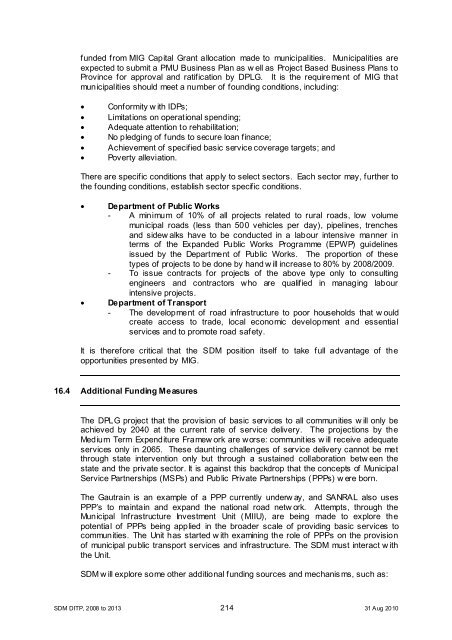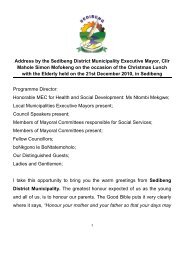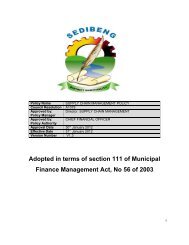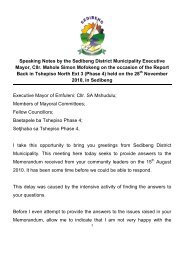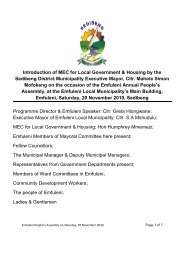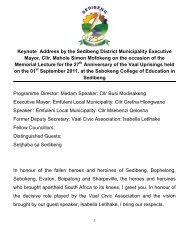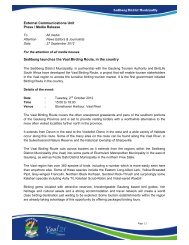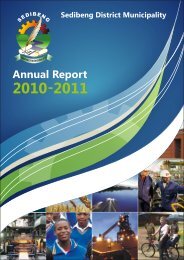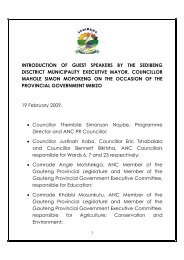Chapter 11 - Sedibeng District Municipality
Chapter 11 - Sedibeng District Municipality
Chapter 11 - Sedibeng District Municipality
You also want an ePaper? Increase the reach of your titles
YUMPU automatically turns print PDFs into web optimized ePapers that Google loves.
funded from MIG Capital Grant allocation made to municipalities. Municipalities are<br />
expected to submit a PMU Business Plan as w ell as Project Based Business Plans to<br />
Province for approval and ratification by DPLG. It is the requirement of MIG that<br />
municipalities should meet a number of founding conditions, including:<br />
• Conformity w ith IDPs;<br />
• Limitations on operational spending;<br />
• Adequate attention to rehabilitation;<br />
• No pledging of funds to secure loan finance;<br />
• Achievement of specified basic service coverage targets; and<br />
• Poverty alleviation.<br />
There are specific conditions that apply to select sectors. Each sector may, further to<br />
the founding conditions, establish sector specific conditions.<br />
• Department of Public Works<br />
- A minimum of 10% of all projects related to rural roads, low volume<br />
municipal roads (less than 500 vehicles per day), pipelines, trenches<br />
and sidew alks have to be conducted in a labour intensive manner in<br />
terms of the Expanded Public Works Programme (EPWP) guidelines<br />
issued by the Department of Public Works. The proportion of these<br />
types of projects to be done by hand w ill increase to 80% by 2008/2009.<br />
- To issue contracts for projects of the above type only to consulting<br />
engineers and contractors who are qualified in managing labour<br />
intensive projects.<br />
• Department of Transport<br />
- The development of road infrastructure to poor households that w ould<br />
create access to trade, local economic development and essential<br />
services and to promote road safety.<br />
It is therefore critical that the SDM position itself to take full advantage of the<br />
opportunities presented by MIG.<br />
16.4 Additional Funding Measures<br />
The DPLG project that the provision of basic services to all communities w ill only be<br />
achieved by 2040 at the current rate of service delivery. The projections by the<br />
Medium Term Expenditure Framew ork are worse: communities w ill receive adequate<br />
services only in 2065. These daunting challenges of service delivery cannot be met<br />
through state intervention only but through a sustained collaboration betw een the<br />
state and the private sector. It is against this backdrop that the concepts of Municipal<br />
Service Partnerships (MSPs) and Public Private Partnerships (PPPs) w ere born.<br />
The Gautrain is an example of a PPP currently underw ay, and SANRAL also uses<br />
PPP’s to maintain and expand the national road netw ork. Attempts, through the<br />
Municipal Infrastructure Investment Unit (MIIU), are being made to explore the<br />
potential of PPPs being applied in the broader scale of providing basic services to<br />
communities. The Unit has started w ith examining the role of PPPs on the provision<br />
of municipal public transport services and infrastructure. The SDM must interact w ith<br />
the Unit.<br />
SDM w ill explore some other additional funding sources and mechanis ms, such as:<br />
SDM DITP, 2008 to 2013 214 31 Aug 2010


